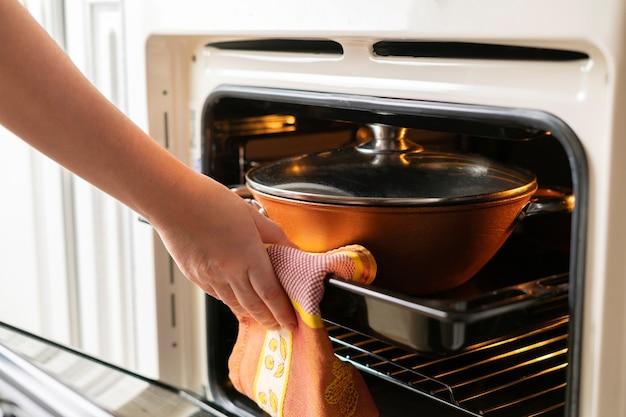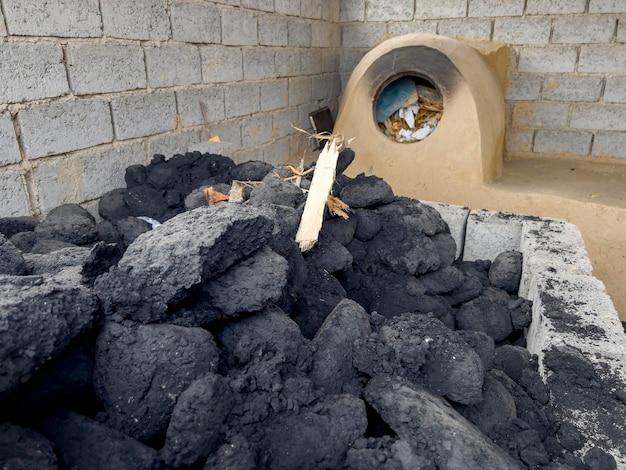Are you tired of scrubbing your oven for hours, battling with stubborn baked-on carbon? Look no further – we have the solution you need! Cleaning your oven may not be the most exciting task, but with our tips and tricks, it doesn’t have to be a daunting chore.
In this comprehensive guide, we will provide you with effective methods to remove baked-on carbon from your oven, leaving it spotless and ready for your next culinary adventure. Whether you’re dealing with burnt-on fat, carbon residue, or hardened grease, we’ve got you covered. Say goodbye to scrubbing for hours and hello to a shiny, clean oven.
So, put on your cleaning gloves and let’s dive into the world of oven cleaning, where we’ll explore the best methods and products to tackle even the toughest carbon buildup.
How to Banish Baked-On Carbon from Your Oven
Introduction:
No one likes cleaning the oven. It’s a dirty job that often gets postponed until the baked-on carbon starts to resemble a medieval fortress. But fear not, brave kitchen warriors! In this guide, we’ll equip you with super-effective strategies to conquer that stubborn carbon and restore your oven to its former glory. So put on your cleaning gloves and let’s dive in!
Why Does Carbon Keep Sticking Around Like That
Before we unleash our cleaning arsenal, let’s take a moment to understand why carbon is so clingy. When food splatters or drips inside the oven, it bakes onto the surfaces due to the intense heat. The carbonized residue can be notoriously stubborn to remove, but with the right techniques, you’ll be able to vanquish it for good.
The Wonders of Baking Soda and Vinegar
If you’re looking for a non-toxic and budget-friendly solution, look no further than the dynamic duo of baking soda and vinegar. Start by sprinkling a generous amount of baking soda on the carbonized areas. Then, with a spray bottle, apply vinegar until the baking soda forms a satisfyingly fizzy paste. Let it sit for 15 minutes (or longer for extra-stubborn spots) before scrubbing with a sponge or brush. Rinse with water, and rejoice as the carbon makes its hasty retreat!
The Power of Lemon and Heat
Embrace the citric acid goodness of lemons to summon the cleansing power of nature. Squeeze fresh lemon juice onto the carbonized regions of your oven and spread it evenly. Now, let’s turn up the heat! Set your oven to a low temperature and leave it on for 30 minutes. The lemon juice will work its magic, softening the carbon and making it easier to remove. After the oven cools down, wipe away the residue with a damp cloth. Your oven will shine like a lemon-scented beacon!
The Mighty Steam Cleaning Method
Prepare to unleash the power of steam! Fill a heat-resistant bowl with water and add a few drops of dish soap. Place the bowl in the oven and heat it at 250°F (121°C) for 30 minutes. The steam generated will help loosen the carbon buildup. Afterward, don your trusty gloves and wipe away the softened gunk with a cloth or sponge. Feel the satisfaction as the steam conquers the carbon, leaving your oven gleaming and fresh.
The Secret Weapon: Ammonia
When all else fails, it’s time to bring out the big guns: ammonia. This method requires caution, so prepare your cleaning battle station with proper ventilation and wear protective gloves. Place a small bowl of ammonia on the oven rack and leave it overnight. The fumes will penetrate the carbon, making it easier to remove the next day. With the help of a non-abrasive sponge or cloth, wipe the carbon away. Be sure to rinse thoroughly to eliminate any ammonia residue. You’ve conquered the carbon, and your oven is now ammonia-zingly clean!
Prevention is Key: Use Oven Liners
Now that your oven is sparkling, it’s time for some preventative measures. Invest in oven liners or baking sheets to catch any spills or drips before they have the chance to join forces with carbon. Cleaning an oven with a liner is as easy as pie, and your future self will thank you for the hassle-free maintenance.
Conclusion:
Cleaning baked-on carbon from your oven doesn’t have to be a nightmare. With the right techniques and a touch of humor, you can conquer even the toughest greasy fortresses. Remember to arm yourself with baking soda, vinegar, lemons, steam, and, as a last resort, ammonia. And don’t forget to employ some preventative measures to keep your oven looking crisp and carbon-free. So get cleaning, and show that stubborn carbon who’s boss in the kitchen! Happy cleaning!
FAQ: How to Remove Baked-On Carbon from Your Oven
Welcome to our FAQ guide on how to remove that stubborn baked-on carbon from your oven. We understand the frustration of dealing with a greasy, dirty oven, and we’re here to help you get it sparkling clean again. Check out the answers to some frequently asked questions below:
How Do You Get Burnt-On Fat Out of the Oven
To tackle burnt-on fat in your oven, you’ll need a powerful degreaser. Mix a solution of warm water and dish soap, then apply it to the baked-on fat. Let it sit for a few minutes to loosen the grease, then scrub gently with a soft sponge or cloth. Rinse thoroughly with clean water.
What Chemical Will Dissolve Carbon
One effective chemical for dissolving carbon is sodium bicarbonate, commonly known as baking soda. Mix baking soda with water to form a paste, then apply it to the carbon buildup in your oven. Let it sit for a while to allow the baking soda to work its magic, then wipe clean with a damp cloth.
How Do You Remove Carbon from Metal
Removing carbon from metal can be a bit trickier. One popular method is to use a mix of vinegar and baking soda. Apply the mixture to the carbonized metal and let it sit for a few minutes to break down the carbon. Then, scrub with a brush or scouring pad and rinse thoroughly.
Will Caustic Soda Remove Carbon
Yes, caustic soda, also known as sodium hydroxide, is a potent chemical that can effectively remove carbon. However, it is highly caustic and should be handled with extreme caution. Make sure to follow all safety guidelines and instructions when using caustic soda.
Does Acetone Remove Carbon
Yes, acetone is another solvent that can be used to remove carbon deposits. Apply a small amount of acetone to a cloth or sponge and gently scrub the carbonized area. Remember to ventilate the room properly as acetone can be quite potent.
How Do I Get Baked-On Grease Off My Oven Racks
One excellent method to remove baked-on grease from oven racks is by using a vinegar and baking soda solution. Lay the racks on a towel, sprinkle them with baking soda, and then spray vinegar over the top. Let the solution fizz and work its magic for a few minutes, then scrub the racks clean with a brush. Rinse thoroughly before placing them back into the oven.
How Do You Dissolve Hardened Grease
To dissolve hardened grease, you can try using a mixture of equal parts dish soap and warm water. Apply the mixture to the hardened grease, then let it sit for a few minutes to break it down. Scrub the area gently with a brush, then rinse thoroughly with water.
Does Vinegar Damage Stainless Steel
No, vinegar does not damage stainless steel. In fact, it can be an excellent cleaning agent for stainless steel surfaces. However, it’s important to rinse the vinegar off thoroughly to prevent any potential discoloration or residue.
What Removes Carbon Residue
A mixture of hydrogen peroxide and baking soda can effectively remove carbon residue. Create a paste with these two ingredients and apply it to the carbonized area. Let it sit for a while, then scrub gently with a sponge or cloth. Rinse thoroughly afterward.
Does Carb Cleaner Break Down Carbon
Yes, carb cleaner is specifically designed to break down carbon deposits in engines. However, it may not be safe to use on household appliances like ovens. Stick to oven-specific cleaners or more natural alternatives for cleaning your oven.
How Do You Dissolve Carbon Black
To dissolve carbon black, a mixture of hydrogen peroxide and ammonia can be effective. Apply the mixture to the carbon black stain and let it sit for a while. Scrub gently, then rinse thoroughly with water.
Does WD-40 Remove Carbon
Yes, WD-40 can be used to remove carbon buildup. Apply WD-40 to a cloth or sponge, then gently scrub the carbonized area. Rinse thoroughly afterward to remove any residue.
Does Vinegar Remove Carbon
Vinegar is excellent for removing carbon deposits. Mix equal parts vinegar and water, then apply the solution to the carbonized area. Let it sit for a while, then gently scrub and rinse thoroughly.
How Do You Get Burnt Carbon Out of the Oven
To get rid of burnt carbon in your oven, you can use a paste made from baking soda and water. Apply the paste to the affected areas and let it sit for a few hours or overnight. Then, scrub the carbon off with a sponge or brush and wipe clean.
How Do I Get the Black Stuff off My Burnt Pan
If your pan has a black, burnt-on residue, try boiling a solution of equal parts water and vinegar in the pan. Allow it to simmer for a few minutes, then remove from heat and let it cool. Scrub the pan with a brush or sponge to remove the black residue, then wash and rinse thoroughly.
Does Kerosene Remove Carbon
Yes, kerosene can be used to remove carbon deposits. However, caution must be exercised when using kerosene due to its flammability. Ensure proper ventilation and follow safety instructions when using kerosene as a cleaning agent.
What Do Professionals Clean Ovens With
Professional oven cleaners often use commercial oven cleaners, which are specially formulated to tackle tough grease and carbon buildup. These cleaners typically contain strong chemicals, so it’s important to use them according to the manufacturer’s instructions and consider proper ventilation.
How Do You Remove Carbon Stains
Carbon stains can be challenging to remove, but a mixture of hydrogen peroxide and baking soda can be effective. Apply the paste to the carbon stain, let it sit for a while, then scrub gently with a brush or cloth. Rinse thoroughly afterward.
What Is in Caustic Soda
Caustic soda, or sodium hydroxide, is a strong alkaline chemical. It is composed of sodium, oxygen, and hydrogen, making it highly effective for cleaning purposes. Caustic soda is commonly used in various cleaning applications, but it should be handled with care due to its corrosive nature.
How Do You Remove Carbon Buildup from Stainless Steel
To remove carbon buildup from stainless steel, make a paste using baking soda and water. Apply the paste to the carbonized area and let it sit for some time. Gently scrub with a sponge or brush, then rinse thoroughly with clean water.
How Do You Dissolve Burnt Carbon
A mixture of ammonia and warm water can be used to dissolve burnt carbon. Create a solution with equal parts of each, then soak the affected area or apply it with a sponge. Let it sit for a while, then scrub gently and rinse thoroughly.
We hope this FAQ guide has provided you with valuable insights on removing baked-on carbon from your oven. Remember to always follow safety guidelines and use appropriate cleaning methods for your specific oven type. Happy cleaning!
Disclaimer: The information provided in this FAQ guide is intended for informational purposes only. Always exercise caution and refer to the manufacturer’s instructions when using any cleaning agents or chemicals.

